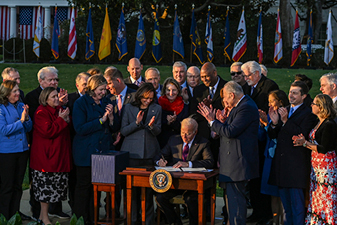|
By Cecile Entleitner, Associate, Blakey & Agnew
The transportation industry and infrastructure policy enthusiasts certainly have much to be thankful for this Thanksgiving. Following months of negotiations, procedural hiccups, and several delays, the $1 trillion Infrastructure Investment and Jobs Act (IIJA) has passed both chambers of Congress and was signed into law. On November 15, President Biden formally signed the legislation during a ceremony on the White House lawn, attended by a bipartisan crowd of Members of Congress, Mayors, and Governors.
Much like many of the infrastructure assets the bill's funding aims to address, the IIJA's path to passage faced numerous roadblocks and, at times, appeared at risk of crumbling. The legislation was originally drafted by a bipartisan group of Senators over the summer and subsequently passed the Senate on August 10 by a vote of 69-30, with 19 Republicans joining all Democrats in support of the bill. The IIJA was sent to the House of Representatives for a final vote, which quickly proved more challenging than anticipated.
Due to Democrats' slim majority in the House, the caucus needed nearly unified support in order to pass the IIJA. The matter became even trickier when the White House and congressional leadership unofficially linked the IIJA to the broader Build Back Better reconciliation bill, indicating one could not move forward without the other. Many members of the House Progressive Caucus vowed to withhold support from the IIJA until the Build Back Better Act, which was still in the early drafting stages, was finalized. As a result, the IIJA vote was postponed several times to allow additional negotiations on the reconciliation bill, which incorporates environmental programs, health care, and education investments, among other Democratic priorities. While the package still has not been finalized, a framework was published and an agreement was reached in November, clearing the way for the IIJA. The long-awaited bipartisan infrastructure bill passed the House on November 5 by a 228-206 vote – mostly along party lines.
The IIJA is comprised of a full five-year surface transportation reauthorization, which is approximately $90 billion above baseline funding levels under the 2015 FAST Act, as well as $184 billion in one-time direct appropriations over five years. Overall, the IIJA provides $567.4 billion over five years for the U.S. Department of Transportation (USDOT), a significant increase from the $293.5 billion within the FAST Act.
The bill contains many freight funding and policy provisions worth celebrating. The legislation establishes a new Office of Multimodal Freight Infrastructure and Policy, led by an Assistant Secretary for Multimodal Freight. The office will guide national and state freight planning across transportation modes and implement and administer multimodal freight grant programs. Among these programs is the popular INFRA grant program, a freight-specific program aimed at large infrastructure projects. The IIJA provides $8 billion over five years for the INFRA program, a 78 percent increase from the FAST Act, and raises the amount of funding available to non-highway freight projects from roughly 11 percent to 30 percent annually. The IIJA also creates a new discretionary grant program, the
|

National Infrastructure Project Assistance program, funded at $5 billion over five years. While this program is also geared toward large infrastructure projects, it will address different project needs as funding eligibility under the new program is not constrained by mode and open to a broader range of projects, including: highway and bridge projects; intermodal freight, rail, and port projects; railway-highway grade separation or elimination projects; passenger rail projects; and public transportation projects. To support smaller projects with local or regional impacts, the IIJA provides $7.5 billion over five years for the TIGER/BUILD/RAISE grant program. Although this program has been in place (under several different names) since 2009, it had previously been subject to the annual appropriations process. Under the IIJA, the program is contained within reauthorization law for the first time, providing funding certainty for at least five years.
Additionally, the IIJA reauthorizes the freight formula program created by the FAST Act, which apportions funding to each state for their individual freight project needs. The program will receive $7.15 billion over five years and, similarly to the INFRA grant program, the maximum amount of funding available to non-highway freight projects has been increased from 10 percent to 30 percent. Various other funding programs within the IIJA also contain eligibility for multimodal freight projects, including: $2.25 billion for the Port Infrastructure Development Program (PIDP) to improve facilities, operations, and intermodal connections near or within seaports, inland ports, and Great Lakes ports; $5 billion for the Consolidated Rail Infrastructure and Safety Improvements (CRISI) program for projects that improve the safety, efficiency, and reliability of intercity passenger and freight rail; $3 billion for a new grant program for highway-rail or pathway-rail grade crossing improvement projects; $400 million for a new grant program to reduce truck emissions at port facilities; and a total of $40 billion for two new bridge investment programs: $27.5 billion will go toward a formula program for bridge replacement, rehabilitation, preservation, protection, and construction projects and $12.5 billion is provided for a discretionary grant program to replace, rehabilitate, preserve, or protect bridges on the National Bridge Inventory.
With the IIJA's funding and programs officially written into law, the transportation industry and freight sector will now look to USDOT and its forthcoming Freight Office for policy guidance, rulemakings, and procedures to begin implementing IIJA programs and distributing funding for much-needed freight investment projects across the country.
Blakey & Agnew, LLC is a public affairs and
communications consulting firm based in
Washington, DC.
|


